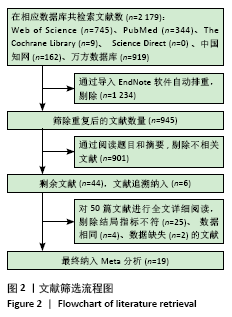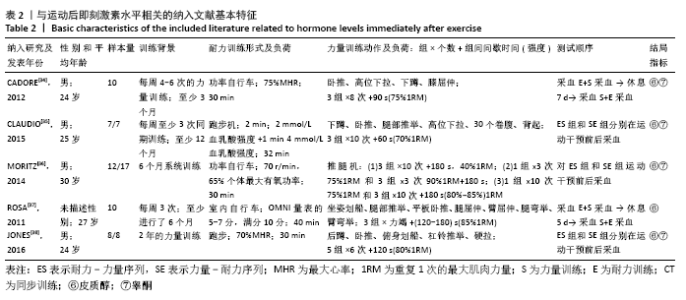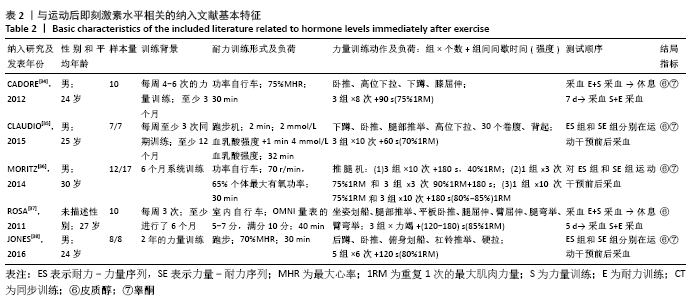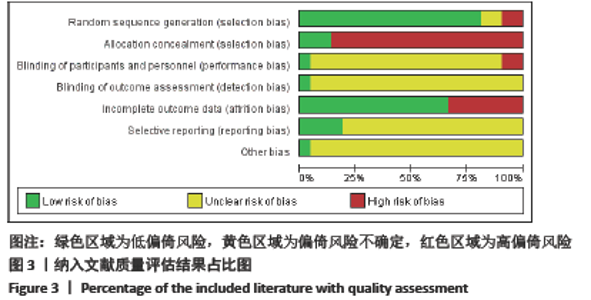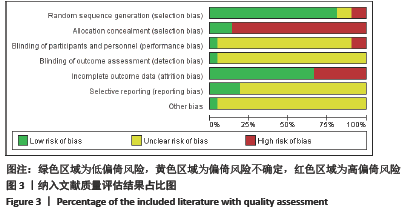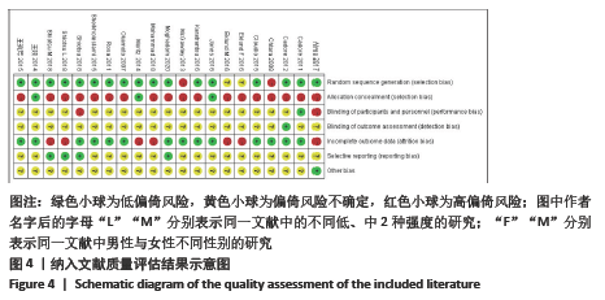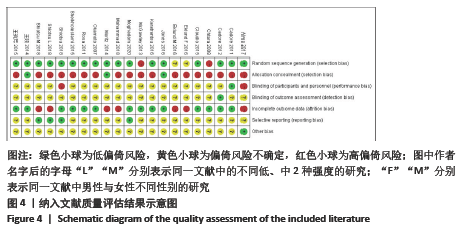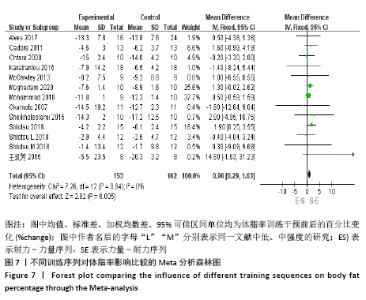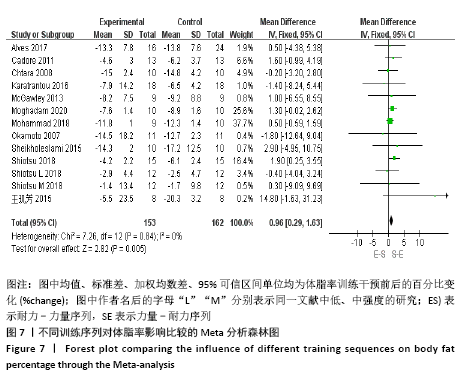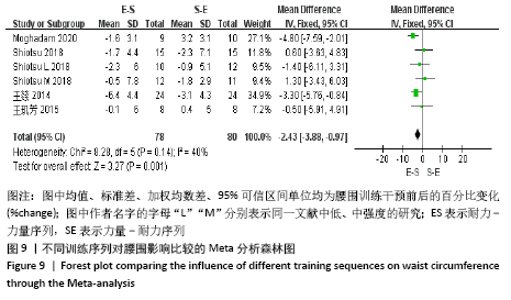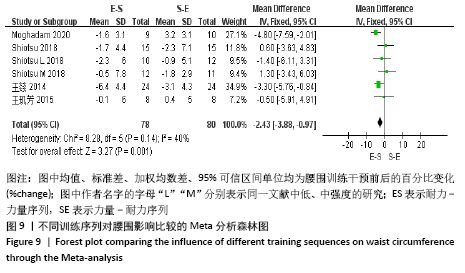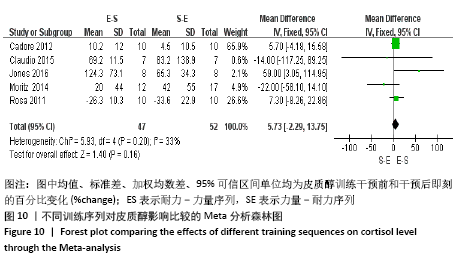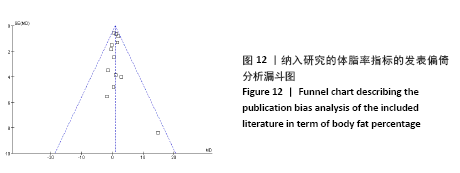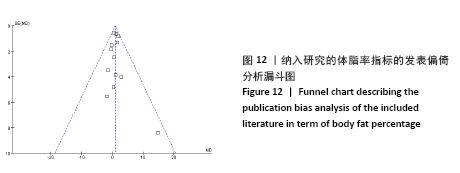Chinese Journal of Tissue Engineering Research ›› 2022, Vol. 26 ›› Issue (8): 1305-1312.doi: 10.12307/2022.240
Effect of concurrent training sequences on body composition and hormone response: a Meta-analysis
Wu Min1, Zhang Yeting2, Wang Lu3, Wang Junwei4, Jin Yu3, Shan Jixin5, Bai Bingyi3, Yuan Qiongjia3
- 1School of Kinesiology, Shanghai University of Sport, Shanghai 200438, China; 2School of Physical Education, Chengdu University, Chengdu 610106, Sichuan Province, China; 3School of Sports Medicine and Health, Chengdu Sport University, Chengdu 610041, Sichuan Province, China; 4School of Human Movement Sciences, Beijing Sport University, Beijing 100084, China; 5Sports Hospital Affiliated to Chengdu Sport University, Chengdu 610041, Sichuan Province, China
-
Received:2020-12-28Revised:2020-12-30Accepted:2021-01-23Online:2022-03-18Published:2021-11-02 -
Contact:Yuan Qiongjia, MD, Professor, Doctoral supervisor, School of Sports Medicine and Health, Chengdu Sport University, Chengdu 610041, Sichuan Province, China -
About author:Wu Min, MD candidate, School of Kinesiology, Shanghai University of Sport, Shanghai 200438, China -
Supported by:the National Natural Science Foundation of China, No. 31900848 (to WL); Establishment of National Physical Health Cloud Platform in Sichuan Province, No. 18PTDJ (to YQJ)
CLC Number:
Cite this article
Wu Min, Zhang Yeting, Wang Lu, Wang Junwei, Jin Yu, Shan Jixin, Bai Bingyi, Yuan Qiongjia. Effect of concurrent training sequences on body composition and hormone response: a Meta-analysis[J]. Chinese Journal of Tissue Engineering Research, 2022, 26(8): 1305-1312.
share this article
Add to citation manager EndNote|Reference Manager|ProCite|BibTeX|RefWorks

2.2 纳入文献基本特征和质量评估结果 此19篇文献的基本特征见表1,2,对19篇文献进行了7个方面的偏倚风险评估,结果见图3,4。根据改良Jadad评分仅3篇文献高质量研究[32,36,38]。 为了方便接下来的研究,文章将所有“耐力-力量训练序列”统称为“ES”,将“力量-耐力训练序列”统称为“SE”。Meta分析共纳入510例受试者,ES组259例,SE组271例。有2项研究在激素指标的测量中分别共用了10名受试者[34,36],仅中间休息了7 d和5 d使得测试时间不同。因此,总受试者小于2组例数之和。纳入文献中对于不同序列的耐力和力量同步训练分组命名有:MOHAMMAD等[28]的ES(耐力合并力量)和SE(力量合并耐力)、SHEIKHOLESLAMI等[30]的CER(同步训练中耐力合并力量)和CRE(同步训练中力量合并耐力)、SHIOTSU等[31]的AR(有氧合并力量)和RA(力量合并有氧)和ROSA等[37]的CT1(同步训练方案1)和CT2(同步训练方案2)等。 "
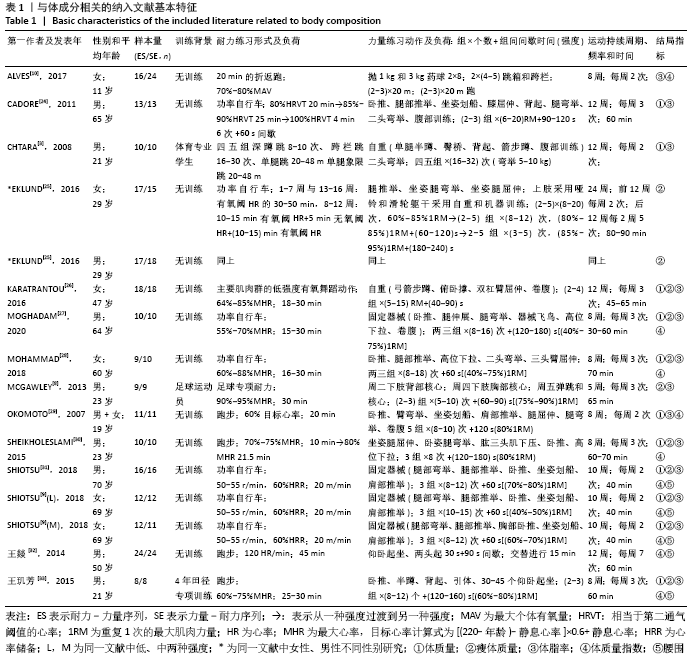

2.3 Meta分析结果 2.3.1 各组体质量的合并效应结果差异 纳入的10篇文献中[3,9,24,26-31,33],SHIOTSU等[9]描述了2种不同训练强度,最终纳入11组ES和SE对体质量百分比变化比较的效应量数据,见图5。异质性检验的结果显示,各研究间存在异质性(P=0.005,I2=60%),采用敏感性分析剔除1篇文献后异质性消失但显著性差异结果没有发生改变[26],可能是由于该研究的耐力训练方案设计为有氧舞蹈训练造成,但最终结果仍然稳定可靠。如图5所示,ES与SE干预前后的体质量百分比变化(%change)差异无显著性意义(WMD=-0.35,95%CI:-2.28%-1.58,P > 0.05)。"
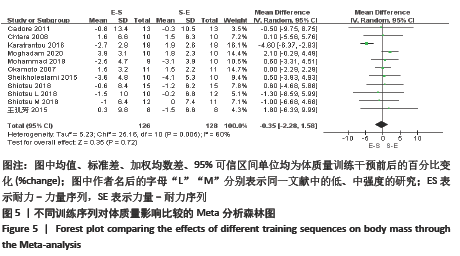
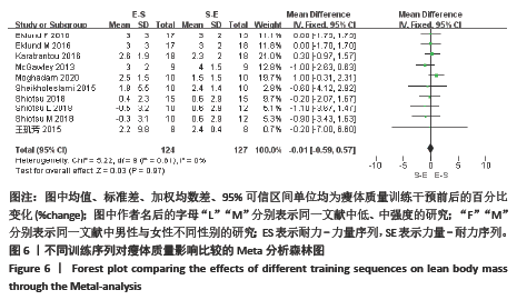
2.3.2 两组瘦体质量的合并效应结果差异 共有8篇不同序列同步训练对瘦体质量的干预研究[8-9,25-27,30-31,33],SHIOTSU等[9]纳入了2种不同训练强度,EKLUND等[25]纳入了不同性别。因此,瘦体质量变化的Meta分析最终纳入了10组百分比变化比较的效应量数据,见图6。异质性检验的结果显示,各研究间不存在异质性(P=0.81,I2=0%),故采用固定效应模型进行分析。合并效应量的结果显示:ES与SE的瘦体质量干预前后百分比变化(%change)无显著性差异(WMD=-0.01,95%CI:-0.59-0.57,P > 0.05)。因此,在同步训练当中ES和SE之间可能不具有序列上的差异。"
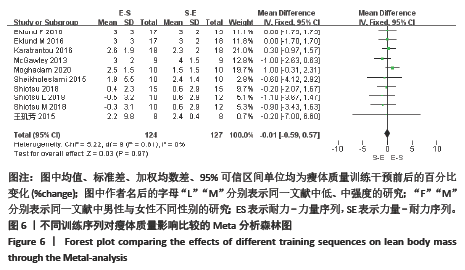

2.3.4 体脂率的亚组分析结果 ES与SE的不同可能会受到其他复杂干扰因素的影响。因此,研究继续从训练背景、训练周期、性别、年龄等因素角度进一步对12篇含体脂率指标的文献进行亚组分析[3,8-10,24,26-31,33],见表3。 在亚组分析的训练背景当中3篇纳入研究的受试者具有一定年限的训练背 景[3,8,33],其中2篇研究的受试者是体育专业学生[3,33],1篇研究的受试者是半职业和职业足球运动员[8]。纳入的研究中有1篇训练周期为5周[8];6篇为8周[10,27-30,33];2篇为10周[9,31];4篇为12周[3,24,26,32]。在对纳入的12篇文献进行性别因素的亚组分析时,剔除了1项受试者分组为男女混合的研究[29]。 亚组分析结果表明:无训练背景的受试者同步训练中降低体脂率采用SE更佳(P < 0.01)。无论是5-8周还是10-24周的同步训练均具有不同序列的显著性差异(P < 0.05),表明短期的同步训练中SE已经具有优势。性别和年龄的分析显示,SE的优势可能更多地存在于男性中(P < 0.01),女性受试者无显著性差异(P > 0.05),老年群体可能更具有优势(P < 0.01)。"
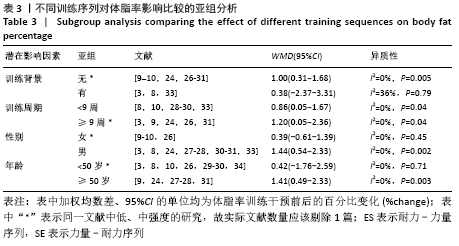
| [1] BALABINIS CP, PSARAKIS CH, MOUKAS M, et al. Early phase changes by concurrent endurance and strengthtraining. J Strength Cond Res. 2003;17(2):393-401. [2] HICKSON RC. Interference of strength development by simulta-neously training for strength and endurance. Eur J Appl Physiol Occup Physiol. 1980;45(2-3):255-263. [3] CHTARA M, CHAOUACHI A, LEVIN GT, et al. Effect of concurrent endurance and circuit resistance training sequence on muscular strength and power development. J Strength Cond Res. 2008;22(4):1037. [4] MIKKOLA J, RUSKO H, IZQUIERDO M, et al. Neuromuscular and cardiovascular adaptations during concurrent strength and endurance training in untrained men. Intl J Sports Med. 2012;33(9):702-710. [5] REED JP, SCHILLING BK, MURLASITS Z. Acute neuromuscular and metabolic responses to concurrent endurance and resistance exercise. J Strength Cond Res. 2013;27(3):793-801. [6] Schumann M, Küüsmaa M, Newton RU, et al. Fitness and lean mass increases during combined training independent of loading order. Med Sci in Sports Exerc. 2014;46(9):1758-1768. [7] Tarasi Z, Beiki Y, Hossini F, et al. The effect of the sequence of concurrent strength and endurance training on aerobic capacity, anaerobic capacity and maximum strength of male adolescents. AUS J Basic and Appli Sci. 2011;5(10):1195-1201. [8] MCGAWLEY K, ANDERSSON PI. The order of concurrent training does not affect soccer-related performance adaptations. Int J sports Med. 2013;34(11):983-990. [9] SHIOTSU MS, YUYA W, SHOTARO T, et al. Effect of exercise order of combined aerobic and resistance training on arterial stiffness in older men. Exp Gerontol. 2018;111:27-34. [10] ALVES AR, MARTA CC, NEIVA HP, et al. Effects of order and sequence of resistance and endurance training on body fat in elementary school-aged girls. Biol Sport. 2017;34(4):379-384. [11] ELIAS M. Serum cortisol, testosterone, and testosterone‐binding globulin responses to competitive fighting in human males. Aggressive Behav. 1981;7(3):215-224. [12] GLADUE BA, BOECHLER M, MCCAUL KD. Hormonal response to competition in human males. Aggress Behav. 1989;15(6): 409-422. [13] WANG ZM, PIERSON RN, HEYMSFIELD SB. The five-level model: a new approach to organizing body-composition research. Am J Clin Nutr. 1992;56(1):19-28. [14] DE MUTSERT R, SUN Q, WILLETT WC, et al. Overweight in early adulthood, adult weight change, and risk of type 2 diabetes, cardiovascular diseases, and certain cancers in men: a cohort study. Am J of Epidemiol. 2014;179(11):1353-1365. [15] NORA M, GUIMARAES M, ALMEIDA R, et al. Excess body mass index loss predicts metabolic syndrome remission after gastric bypass. Diabetol Metab Syndr. 2014;6(1):1. [16] PHILLIPS LK, PRINS JB. The link between abdominal obesity and the metabolic syndrome. Curr Hypertens Rep. 2008;10(2): 156-164. [17] HASLAM DW, JAMES WPT. Obesity. Lancet. 2005;366(9492):1197-1209. [18] SCHULZE MB, BERGMANN MM, HEIDEMANN C, et al. Comparison of anthropoinetric characteristics in predicting the incidence of type 2 diabetes in the EPIC-potsdam study. Diabetes Care. 2006; 29(8):1921-1923. [19] URHAUSEN A, GABRIEL H, KINDERMANN W. Blood hormones as markers of training stress and overtraining. Sports Med. 1995; 20(4):251-276. [20] EDDENS L, SOMEREN KV, HOWATSON G. The role of intra-session exercise sequence in the interference effect: a systematic review with meta-analysis. Sports Med. 2018;48(1):177-188. [21] CADORE E, LHULLIER F, Brentano M, et al. Correlations between serum and salivary hormonal concentrations in response to resistance exercise. J Sports Sci. 2008; 26(10):1067-1072. [22] KRAEMER WJ, PATTON JF, GORDON, SE, et al. Compatibility of high-intensity strength and endurance training on hormonal and skeletal muscle adaptations. Eur J Appl Physiol. 1995;78(3):976-989. [23] 孙元隆,阮小芬,李益萍,等.辨证论治应用芪苈强心胶囊对缺血性心力衰竭疗效影响的meta分析比较[J].中国中药杂志,2019,44(22):4975-4984. [24] CADORE EL, IZQUIERDO M, ALBERTON CL, et al. Strength prior to endurance intra-session exercise sequence optimizes neuromuscular and cardiovascular gains in elderly men. Exp Gerontol. 2011;47(2): 164-169. [25] EKLUND D, HÄKKINEN A, LAUKKANEN JA, et al. Fitness, body composition and blood lipids following 3 concurrent strength and endurance training modes. Appl Physiol Nutr Metab. 2016;40(5):767-774. [26] KARATRANTOU K, GERODIMOS V, HÄKKINEN K, et al. Health-promoting effects of serial vs. integrated combined strength and aerobic training. Int J Sports Med. 2016;38(1):55-64. [27] MOGHADAM BH, BAGHERI R, ASHTARY-LARKY D, et al. The Effects of Concurrent Training Order on Satellite Cell-Related Markers, Body Composition, Muscular and Cardiorespiratory Fitness in Older Men with Sarcopenia. J Nutr Health Aging. 2020;24(1):796-804. [28] MOHAMMAD F, LALEH B, EBRAHIM B. Effect of sequence order of combined strength and endurance training on new adiposity indices in overweight elderly women. Isokinetics Exer Sci. 2018;26(2): 105. [29] OKAMOTO T, MASUHARA M, IKUTA K. Combined aerobic and resistance training and vascular function: effect of aerobic exercise before and after resistance training. J Appl Physiol. 2007;103(5):1655-1661. [30] SHEIKHOLESLAMI-VATANI D, SIAHKOUHIAN M, HAKIMI M, et al. The effect of concurrent training order on hormonal responses and body composition in obese men. Sci Sports. 2015;30(6):335-341. [31] SHIOTSU Y, YANAGITA M. Comparisons of low-intensity versus moderate-intensity combined aerobic and resistance training on body composition, muscle strength, and functional performance in older women. Menopause. 2018;15(6):668-675. [32] 王燚.有氧运动并腹部肌力训练条件下内容顺序对腹型肥胖患者消脂减肥的效果比较 [J].中国老年学杂志,2014,35(2): 477-478. [33] 王玑芳. 抗阻和有氧耐力的不同混合训练对人体体成分的影响[D].北京:北京体育大学,2015. [34] CADORE EL, IZQUIERDO M, SANTOS MGD, et al. Hormonal responses to concurrent strength and endurance training with different exercise orders. J Strength Cond Res. 2012;26(12):3281-3288. [35] CLAUDIO R, ALVES J, FERNANDES H, et al. Order effects of combined strength and endurance training on testosterone, cortisol, growth hormone, and IGF-1 binding protein 3 in concurrently trained men. J Strength Cond Res. 2015;29(1):74-79. [36] SCHUMANN M, WALKER S, IZQUIERDO M, et al. The order effect of combined endurance and strength loadings on force and hormone responses: effects of prolonged training. Eur J Appl Physiol. 2014;114(4):867. [37] ROSA G, DANTAS EHM, MELLO DBD. The response of serum leptin, cortisol and zinc concentrations to concurrent training. Hormones. 2011;10(3):215. [38] JONES TW, HOWATSON G, RUSSELL M, et al. Effects of strength and endurance exercise order on endocrine responses to concurrent training. Eur J Sport Sci. 2016; 17(3):326-334. [39] MACNEIL LG, GLOVER E, BERGSTRA TG, et al. The order of exercise during concurrent training for rehabilitation does not alter acute genetic expression, mitochondrial enzyme activity or improvements in muscle function. PLoS One. 2014;9(10):1-10. [40] BELL G, PETERSEN S, WESSEL J, et al. Physiological adaptations to concurrent endurance training and low velocity resistance training. Int J Sports Med. 1991; 12(4):384-390. [41] SALE DG, JACOBS I, MACDOUGALL JD, et al. Comparison of two regimens of concurrent strength and endurance training. Med Sci Sports Exerc. 1990;22(3):348-56. [42] LEITE N, LAZAROTTO L, CAVAZZA JF, et al. Effects of aquatic exercise and nutritional guidance on the body composition of obese children and adolescents. Rev Bras Cineantropom Desempenho Hum. 2010;12(4):232-238. [43] KWON HR, HAN KA, KU YH, et al. The effects of resistance training on muscle and body fat mass and muscle strength in type 2 diabetic women. Korean Diabetes J. 2010;34(2):100-110. [44] UCAN Y. Effects of different types of exercises on body composition in young men and women. Life Sci. 2013;10(3): 1799-1806. [45] DOLEZAL BA, POTTEIGER JA. Concurrent resistance and endurance training influence on basalmetabolic rate in nondieting individuals. J Appl Physiol. 1998;85(2):695-700. [46] COPELAND JL, CONSITT LA, TREMBLAY MS. Hormonal responses to endurance and resistance exercise in females aged 19-69 years. J Gerontol. 2002;57(4):B158-B165. [47] TREMBLAY MS. Effect of training status and exercise mode on endogenous steroid hormones in men. J Appl Physiol. 2004;96(2):531-539. [48] KRAEMER WJ, RATAMESS NA. Hormonal responses and adaptation to resistance exercise and training. Sports Med. 2005; 35(4):339-361. [49] 李江源,陈名道.睾酮治疗防止非肥胖老年男子内脏脂肪蓄积和骨骼肌丢失[J].中华内分泌代谢杂志,2008,24(1): 113-114. [50] HOLLAND A, MALEAH R, MICHAEL D, et al. Testosterone inhibits expression of lipogenic genes in visceral fat by an estrogen-dependent mechanism. J Appl Physiol. 2016;121(3):792-805. [51] FYFE JJ, BISHOP DJ, STEPTO NK. Interference between concurrent resistance and endurance exercise: molecular bases andthe role of individual training variables. Sports Med. 2014;44(6):743-762. |
| [1] | Liu Gang, Ma Chao, Wang Le, Zeng Jie, Jiao Yong, Zhao Yi, Ren Jingpei, Hu Chuanyu, Xu Lin, Mu Xiaohong. Ankle-foot orthoses improve motor function of children with cerebral palsy: a Meta-analysis based on 12 randomized controlled trials [J]. Chinese Journal of Tissue Engineering Research, 2022, 26(8): 1299-1304. |
| [2] | Liu Yiyi, Qiu Junqiang, Yi Longyan, Zhou Cailiang. Effect of resistance training on interleukin-6 and C-reactive protein in middle-age and elderly people: a Meta-analysis [J]. Chinese Journal of Tissue Engineering Research, 2022, 26(5): 804-812. |
| [3] | Wang Nan, Qian Yuzhang, Xie Lin. Network Meta-analysis of different acupuncture methods for the treatment of lumbar disc herniation [J]. Chinese Journal of Tissue Engineering Research, 2022, 26(5): 813-820. |
| [4] | Wei Zhoudan, Li Wenjin, Zhu Li, Wang Yu, Zhao Jiaoyang, Chen Yanan, Guo Dong, Hao Min. Platelet-rich fibrin as a material for alveolar ridge preservation significantly reduces the resorption of alveolar bone height and width after tooth extraction: a meta-analysis [J]. Chinese Journal of Tissue Engineering Research, 2022, 26(4): 643-648. |
| [5] | Ou Liang, Kong Dezhong, Xu Daoqing, Ni Jing, Fu Xingqian, Huang Weichen. Comparative clinical efficacy of polymethyl methacrylate and self-solidifying calcium phosphate cement in vertebroplasty: a meta-analysis [J]. Chinese Journal of Tissue Engineering Research, 2022, 26(4): 649-656. |
| [6] | Yang Ruijia, Jiang Lingkai, Dong Zhengquan, Wang Yunfei, Ma Zhou, Cong Linlin, Guo Yanjing, Gao Yangyang, Li Pengcui. Open reduction and internal fixation versus circular external fixation for tibial plateau fractures: a meta-analysis [J]. Chinese Journal of Tissue Engineering Research, 2022, 26(3): 480-486. |
| [7] | Zhong Yuanming, He Bingkun, Wu Zhuotan, Wu Sixian, Wan Tong, Zhong Xifeng. Meta-analysis of efficacy and safety of Jack kyphoplasty for osteoporotic vertebral compression fractures [J]. Chinese Journal of Tissue Engineering Research, 2022, 26(3): 487-492. |
| [8] | Diao Yulei, Zong Xiaorui, Deng Zhibo, Shu Han. Analgesic effect of adductor canal block versus femoral nerve block after autogenous bone-tendon-bone reconstruction of the anterior cruciate ligament: an updated Meta-analysis [J]. Chinese Journal of Tissue Engineering Research, 2022, 26(2): 315-320. |
| [9] | Chen Junming, Yue Chen, He Peilin, Zhang Juntao, Sun Moyuan, Liu Youwen. Hip arthroplasty versus proximal femoral nail antirotation for intertrochanteric fractures in older adults: a meta-analysis [J]. Chinese Journal of Tissue Engineering Research, 2021, 25(9): 1452-1457. |
| [10] | Chen Jinping, Li Kui, Chen Qian, Guo Haoran, Zhang Yingbo, Wei Peng. Meta-analysis of the efficacy and safety of tranexamic acid in open spinal surgery [J]. Chinese Journal of Tissue Engineering Research, 2021, 25(9): 1458-1464. |
| [11] | Hu Kai, Qiao Xiaohong, Zhang Yonghong, Wang Dong, Qin Sihe. Treatment of displaced intra-articular calcaneal fractures with cannulated screws and plates: a meta-analysis of 15 randomized controlled trials [J]. Chinese Journal of Tissue Engineering Research, 2021, 25(9): 1465-1470. |
| [12] | Huang Dengcheng, Wang Zhike, Cao Xuewei. Comparison of the short-term efficacy of extracorporeal shock wave therapy for middle-aged and elderly knee osteoarthritis: a meta-analysis [J]. Chinese Journal of Tissue Engineering Research, 2021, 25(9): 1471-1476. |
| [13] | Wang Yongsheng, Wu Yang, Li Yanchun. Effect of acute high-intensity exercise on appetite hormones in adults: a meta-analysis [J]. Chinese Journal of Tissue Engineering Research, 2021, 25(8): 1305-1312. |
| [14] | Kong Desheng, He Jingjing, Feng Baofeng, Guo Ruiyun, Asiamah Ernest Amponsah, Lü Fei, Zhang Shuhan, Zhang Xiaolin, Ma Jun, Cui Huixian. Efficacy of mesenchymal stem cells in the spinal cord injury of large animal models: a meta-analysis [J]. Chinese Journal of Tissue Engineering Research, 2021, 25(7): 1142-1148. |
| [15] | Huang Dengcheng, Wang Zhike, Cao Xuewei. Intravenous, topical tranexamic acid alone or their combination in total knee arthroplasty: a meta-analysis of randomized controlled trials [J]. Chinese Journal of Tissue Engineering Research, 2021, 25(6): 948-956. |
| Viewed | ||||||
|
Full text |
|
|||||
|
Abstract |
|
|||||

